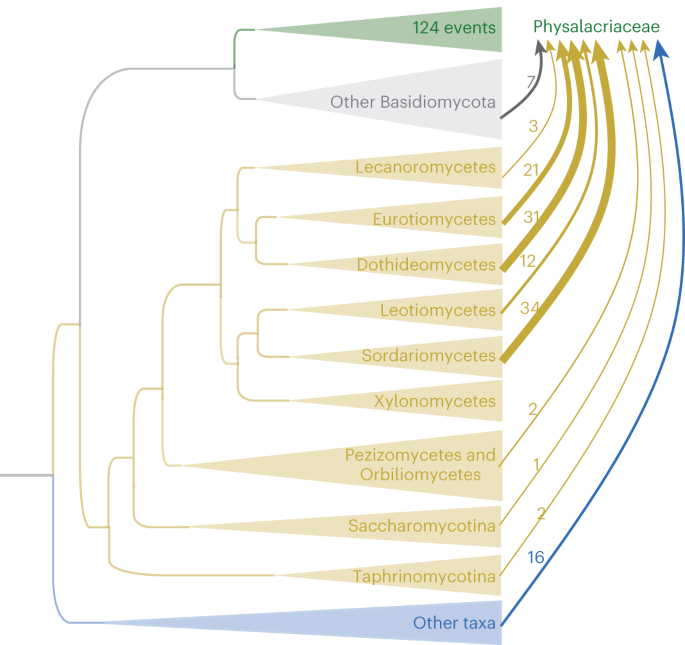Play all audios:
_Armillaria_ species, fungal pathogens prevalent in temperate forests, have acquired hundreds of genes from Ascomycota fungi through horizontal gene transfer. These genes have influenced
_Armillaria_ spp. pathogenicity and plant biomass degradation abilities and contribute to uncovering key insights into the evolutionary history and ecological effects of these fungi. Access
through your institution Buy or subscribe This is a preview of subscription content, access via your institution ACCESS OPTIONS Access through your institution Access Nature and 54 other
Nature Portfolio journals Get Nature+, our best-value online-access subscription $29.99 / 30 days cancel any time Learn more Subscribe to this journal Receive 12 digital issues and online
access to articles $119.00 per year only $9.92 per issue Learn more Buy this article * Purchase on SpringerLink * Instant access to full article PDF Buy now Prices may be subject to local
taxes which are calculated during checkout ADDITIONAL ACCESS OPTIONS: * Log in * Learn about institutional subscriptions * Read our FAQs * Contact customer support REFERENCES * Pan, Y. et
al. A large and persistent carbon sink in the world’s forests. _Science_ 333, 988–993 (2011). THIS REVIEW ARTICLE PROVIDES AN OVERVIEW OF THE FOREST CARBON SINK IN A GLOBAL CONTEXT. Article
CAS PubMed Google Scholar * Riley, R. et al. Extensive sampling of basidiomycete genomes demonstrates inadequacy of the white-rot/brown-rot paradigm for wood decay fungi. _Proc. Natl
Acad. Sci. USA_ 111, 9923–9928 (2014). THIS ARTICLE EMPHASIZES THE NECESSITY OF RE-EVALUATING THE CONVENTIONAL CLASSIFICATION OF WOOD-DECAY FUNGI. Article CAS PubMed PubMed Central
Google Scholar * Sipos, G. et al. Genome expansion and lineage-specific genetic innovations in the forest pathogenic fungi _Armillaria_. _Nat. Ecol. Evol._ 1, 1931–1941 (2017). THIS ARTICLE
PRESENTS A COMPARATIVE GENOMICS STUDY OF _ARMILLARIA_ SPECIES, HIGHLIGHTING INTERESTING FACTS ABOUT THE GENUS. Article PubMed Google Scholar * Sahu, N. et al. Hallmarks of Basidiomycete
soft- and white-rot in wood-decay -omics data of two _Armillaria_ species. _Microorganisms_ 9, 149 (2021). THIS ARTICLE REPORTS TRANSCRIPTOMIC AND PROTEOMIC DATA THAT UNDERPIN UNUSUAL
WHITE-ROT FEATURES IN TWO _ARMILLARIA_ SPECIES. Article CAS PubMed PubMed Central Google Scholar * Schwarze, F. W. M. R. Wood decay under the microscope. _Fungal Biol. Rev._ 21, 133–170
(2007). THIS REVIEW ARTICLE SUMMARIZES SOFT-ROT-LIKE FEATURES IN _ARMILLARIA_ SPP. Article Google Scholar Download references ADDITIONAL INFORMATION PUBLISHER’S NOTE Springer Nature
remains neutral with regard to jurisdictional claims in published maps and institutional affiliations. THIS IS A SUMMARY OF: Sahu, N. et al. Vertical and horizontal gene transfer shaped
plant colonization and biomass degradation in the fungal genus _Armillaria_. _Nat. Microbiol_. https://doi.org/10.1038/s41564-023-01448-1 (2023). RIGHTS AND PERMISSIONS Reprints and
permissions ABOUT THIS ARTICLE CITE THIS ARTICLE Horizontal gene transfer explains unusual traits of _Armillaria_ fungi. _Nat Microbiol_ 8, 1617–1618 (2023).
https://doi.org/10.1038/s41564-023-01460-5 Download citation * Published: 15 August 2023 * Issue Date: September 2023 * DOI: https://doi.org/10.1038/s41564-023-01460-5 SHARE THIS ARTICLE
Anyone you share the following link with will be able to read this content: Get shareable link Sorry, a shareable link is not currently available for this article. Copy to clipboard Provided
by the Springer Nature SharedIt content-sharing initiative

